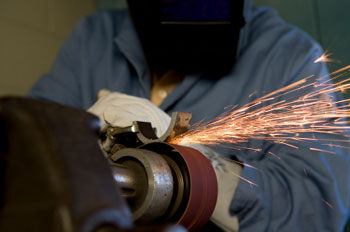By William Hibbard
Spark testing has been around for a very long time and is well regarded by professional and amateur alike. The 1939 edition of the American Society for Metals Handbook had an article written by W.G. Hilgendorf and C.H. McCollam (they were metallurgist and chief chemist, respectively, of Timken Steel and Tube Company at that time) on the subject, giving some good information on the use of this as a tool. I know of several heat-treating shops that always spark test a piece sent in for heat treatment, just to be sure that they will not be held responsible for ruining a job that has been sent to them with poor information about the type of steel used.
A good friend of mine, once head of the finishing department of a tube producer here in town, told me that a spark test was run on the end of every tube in each bundle of tubes after they were loaded into trucks or railroad cars.

A little practice in a slightly darkened area will show you how to distinguish between steels of various compositions. Low carbon steels have a spark that is dullish, without a lot of flowers in the sparks – just a few. As the amount of carbon increases, the flowers increase in number and brilliance. When a piece of high carbon steel, such as piano wire, is tested, the shower of sparks is considerable and very bright. The instructions given by the handbook suggest you observe about the middle third of the spark display to get the best idea of what you have.
All kinds of ferrous metals have their signature sparks. High-speed steel gives of a dull red spark, while oil-hardening steel has an orangey spark with corresponding color flowers or bursts. A little practice with some known steels will help you identify what you have in your hands, so that you don’t try to quench an oil-hardening tool steel in water and have it crack while cooling off.
You can see all this and more at www.digitalmachinist.net. We will also be updating and adding content to both of our websites, so make sure you bookmark www.digitalmachinist.net and www.homeshopmachinist.net today.
Please do us a tremendous favor and forward this e-mail on to your machining friends!
Are you not a subscriber to DIGITAL MACHINIST? Visit us at www.digitalmachinist.net and request a no-obligation issue, or call and request it at 1-800-447-7367. Tell them you received an e-mail from a friend!
And don’t forget to check out Digital Machinist’s page on Facebook and our Twitter feed!
Your friend thinks you’ll enjoy DM, or you wouldn’t have this e-mail!
We hope you enjoyed this e-mail tip, brought to you by your friends at Digital Machinist.
Get Involved!
Do you enjoy our e-mail tips? Has one of them ever “knocked something loose” in your head? Your tip could be a future e-mail blast from your favorite magazine. Just send your tips to george.bulliss@VPDemandCreation.com. If we use your tip, we will extend your subscription by an issue. We like to see 200 to 300 words, plus an image, if available. Thanks!
We hope you enjoyed this e-mail tip, brought to you by your friends at Digital Machinist, dedicated to precision metalworking.
